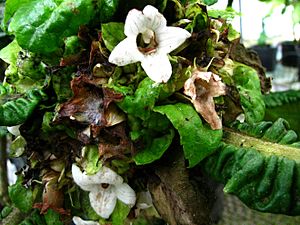Cyrtandra cyaneoides facts for kids
Quick facts for kids Cyrtandra cyaneoides |
|
|---|---|
 |
|
| Conservation status | |
| Scientific classification | |
| Genus: |
Cyrtandra
|
| Species: |
cyaneoides
|
The Cyrtandra cyaneoides, also known as māpele, is a very special and rare flowering plant. It belongs to the African violet family. This plant is endemic to Kauaʻi in Hawaiʻi. This means it grows naturally only on this island and nowhere else in the world.
About the Māpele Plant
The māpele is a type of shrub. It usually grows to be about 1 to 1.3 meters tall. This is roughly the height of a young person. When it blooms, it produces pretty white flowers.
Where Does It Grow?
This plant lives in wet forest areas. You might find it on cliffs or right next to streams. It grows alongside other native Hawaiian plants. Some of these include the ʻākōlea (Boehmeria grandis) and hōʻiʻo (Diplazium sandwichianum). Other plants like ʻieʻie (Freycinetia arborea) and ʻapeʻape (Gunnera kauaiensis) also share its home. Many different types of Cyrtandra plants grow there too.
The ground layer, called the understory, is full of ferns and tiny plants called bryophytes. These include mosses and liverworts. Many trees in these forests also host epiphytes. These are plants that grow on other plants but do not harm them.
Why Is It Endangered?
The māpele plant is very rare. In 1996, it was officially listed as an endangered species. This means it is at high risk of disappearing forever. There are fewer than 800 individual plants left. Scientists found several new groups of these plants between 2003 and 2008.
Threats to the Māpele
The māpele's home is facing problems. Non-native plants have been brought to Hawaiʻi. These plants are called invasive species. They include plants like Koster's curse (Clidemia hirta) and kahili ginger (Hedychium gardnerianum). The Australian tree fern (Sphaeropteris cooperi) is also a problem. These invasive plants compete with the native māpele for sunlight, water, and nutrients. This makes it harder for māpele to grow and survive.
Another threat comes from rats. Rats eat the seeds of the māpele plant. This stops new māpele plants from growing. Protecting the māpele and its habitat is important to help this special plant survive.


